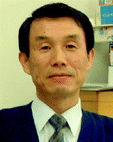DOI: 10.1039/C1CC90172A
(Profile)
Chem. Commun., 2012, 48, 24-25
Interview with Seiji Shinkai
| ||||||
Do you remember what it felt like to publish your first ChemComm article?
My first paper was published in ChemComm in 1968 (DOI: 10.1039/C1968001483B), the title of which was “Hydrolysis of a Phenyl Ester Catalyzed by Hydrophobic Imidazole Derivatives in an Aqueous System”. At that time, I was a student working with Professor Toyoki Kunitake. Before the publication, textbooks and journals had been just reading and learning objects for me. After that, I felt that I suddenly became an author from a reader, a professional researcher from a student. Of course, I felt quite confident that I might be able to become a self-standing researcher. I did not know at that time, however, that I would have a long, long way to go.How has your research evolved from your first to your most recent article?
My first paper was associated with a so-called ‘enzyme model system’. Although it was at a primitive stage, understanding biological events on the basis of chemical, mechanistic viewpoints was very novel and challenging at that time. I was excited when I managed to understand the elaborate and reasonable design principles utilised in the biological system. This stance is consistent throughout my research life, as shown by my research achievements, such as molecular machines, sol–gel transcription, allosteric effects, polysaccharide–DNA complexation, etc.What do you like most about publishing in ChemComm?
ChemComm is edited very concisely and compactly and is therefore excellent for the rapid demonstration of our new ideas. In addition, some journals send one paper to five or six reviewers. It is unlikely that all of these reviewers say ‘yes’, so long discussions with the ‘no’ reviewers start, which sometimes continues for several months. In ChemComm, the editor quickly makes the ‘yes’ or ‘no’ decision, which makes rapid publication possible. I like this principle.My last comment is special but should be common for non-native English speakers. When I was young, some of my papers were rejected only because of poor English. In ChemComm, my English was corrected in many cases, either by the editor or by the reviewer, probably when the paper quality dominated the poor English. This was very helpful for me.
What aspect of your research are you most excited about at the moment?
My research interest has always been associated with dynamic molecular recognition in an interdisciplinary area between chemistry and biology. My targets, however, are shifting from small molecules to large polymers, molecular assemblies, organic/inorganic hybrids, nano/bio hybrids, etc. Furthermore, the recent progress of microscopes, such as SEM, TEM, AFM and STM, is making it easier to visualise structures. When the morphology expected from the chemical structures coincides with the visual image obtained from microscopes, I am really excited.What is the best part of your job?
After partial retirement from Kyushu University in March 2008, I moved to the Institute of Systems, Information Technologies and Nanotechnologies (ISIT) as a president, holding the concurrent position at Sojo University, a private university. ISIT expects me to do some management tasks but I still find doing research the most interesting part of my job. Therefore, I still stick to doing research at ISIT even though I notice that one of the officers fixes me with an icy stare!What is the secret to success in scientific publishing?
This is a difficult question. The time and energy one person has are limited so it is important to direct these efficiently. In the case of research, I believe if I really consider a target to be exciting, it will certainly excite other people and journal readers. Indeed, when we publish these papers, they are cited often without exception. On the other hand, when we start to feel that the research has become a ‘duty’, we had better stop.What is your advice to young emerging scientists?
Like Professor Jean-Marie Lehn, I also consider that science (particularly, chemistry) has several factors common to art. In an art museum, we frequently see painters who are copying famous pictures. However, even though he or she can paint it very skillfully, it is never thought of as a creative work of art. Chemistry is the same. The basic techniques are necessary, but to be established as a true chemist, one has to create something new and different from others and that ‘something’ has to excite other people.What do you do in your spare time?
I scarcely have any spare time; my time is almost filled up with working. But when I do, I read novels or travel to new places. I read novels concerning the mystery of evolution and science fiction novels written by Jiro Nitta. The former is to look for new research ideas. As for the latter, this author was a meteorological scientist and later became a novelist. Hence, his novels are filled with how people behave under severe weather conditions. I feel his novels show how people behave when they encounter serious difficulties.By the time I'm 100 I would liked to have ……
……worked some more but after that I have no plan. If you have any good ideas suitable for a person like me, please let me know!| This journal is © The Royal Society of Chemistry 2012 |

